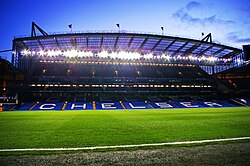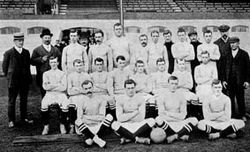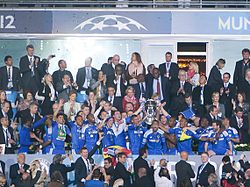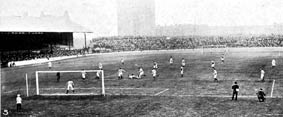




| Full name | Chelsea Football Club |
|---|---|
| Nickname(s) | The Blues, The Pensioners |
| Founded | 10 March 1905[1] |
| Ground | Stamford Bridge, Fulham, London (capacity: 41,837[2]) |
| Owner | Roman Abramovich |
| Chairman | Bruce Buck |
| Manager | José Mourinho |
| League | Premier League |
| 2012–13 | Premier League, 3rd |
Players
First team squad
- As of 16 August 2013.[136]
Note: Flags indicate national team as has been defined under FIFA eligibility rules. Players may hold more than one non-FIFA nationality.
|
|
For recent transfers, see 2013–14 Chelsea F.C. season.
Out on loan
Note: Flags indicate national team as has been defined under FIFA eligibility rules. Players may hold more than one non-FIFA nationality.
|
|
Chelsea Football Club /ˈtʃɛlsiː/ is an English football club based in Fulham, London. Founded in 1905, they play in the Premier League and have spent most of their history in the top tier of English football. Their home is the 41,837-seat[2] Stamford Bridge stadium, where they have played since their establishment.
Chelsea had their first major success in 1955, when they won the league championship, and won various cup competitions during the 1960s, 1970s, 1990s and 2000s. The club has enjoyed its greatest period of success in the past two decades, winning 15 recent major trophies since 1997.[3] Domestically, Chelsea have won four league titles, sevenFA Cups, four League Cups and four FA Community Shields, while in continental competitions they have won two UEFA Cup Winners' Cups, one UEFA Super Cup, one UEFA Europa League and one UEFA Champions League. Chelsea are the only London club to win the UEFA Champions League,[4] one of four clubs, and the only British club, to have won all three main UEFA club competitions, and also the first club to hold two major European titles simultaneously.[5][6]
Chelsea's regular kit colours are royal blue shirts and shorts with white socks. The club's crest has been changed several times in attempts to re-brand the club and modernise its image. The current crest, featuring a ceremonial lion rampant regardant holding a staff, is a modification of the one introduced in the early 1950s.[7] The club has sustained the fifth highest average all-time attendance in English football.[8] Their average home gate for the 2012–13 season was 41,462, the sixth highest in the Premier League.[9] Since July 2003, Chelsea have been owned by Russian billionaireRoman Abramovich.[10] In April 2013 it was ranked by Forbes Magazine as the seventh most valuable football club in the world, at £588 million ($901 million), an increase of 18% from the previous year.[11][12]
History
Main article: History of Chelsea F.C.
In 1904 Gus Mears acquired the Stamford Bridge athletics stadium with the aim of turning it into a football ground. An offer to lease it to nearby Fulham was turned down, so Mears opted to found his own club to use the stadium. As there was already a team named Fulham in the borough, the name of the adjacent borough of Chelsea was chosen for the new club; names like Kensington FC, Stamford Bridge FC and London FC were also considered.[13] Chelsea were founded on 10 March 1905 at The Rising Sun pub (now The Butcher's Hook),[1] opposite the present-day main entrance to the ground on Fulham Road, and were elected to the Football League shortly afterwards.
The club won promotion to the First Division in their second season, and yo-yoed between the First and Second Divisions in their early years. They reached the 1915 FA Cup Final, where they lost to Sheffield United at Old Trafford, and finished 3rd in the First Division in 1920, the club's best league campaign to that point.[14] Chelsea attracted large crowds[15] and had a reputation for signing big-name players,[16] but success continued to elude the club in the inter-war years. Former Arsenal and England centre-forward Ted Drake became manager in 1952 and proceeded to modernise the club. He removed the club's Chelsea pensioner crest, improved the youth set-up and training regime, rebuilt the side with shrewd signings from the lower divisions and amateur leagues, and led Chelsea to their first major trophy success – the League championship – in 1954–55. The following season saw UEFA create the European Champions' Cup, but after objections from The Football League and theFA Chelsea were persuaded to withdraw from the competition before it started.[17] Chelsea failed to build on this success, and spent the remainder of the 1950s in mid-table. Drake was dismissed in 1961 and replaced by player-coach Tommy Docherty.
Docherty built a new team around the group of talented young players emerging from the club's youth set-up and Chelsea challenged for honours throughout the 1960s, enduring several near-misses. They were on course for a treble of League, FA Cup and League Cup going into the final stages of the 1964–65 season, winning the League Cup but faltering late on in the other two.[18] In three seasons the side were beaten in three major semi-finals and were FA Cup runners-up. Under Docherty's successor, Dave Sexton, Chelsea won the FA Cup in 1970, beating Leeds United 2–1 in a final replay. Chelsea took their first European honour, a UEFA Cup Winners' Cup triumph, the following year, with another replayed win, this time over Real Madrid in Athens.
The late 1970s through to the 1980s was a turbulent period for Chelsea. An ambitious redevelopment of Stamford Bridge threatened the financial stability of the club,[19] star players were sold and the team were relegated. Further problems were caused by a notorioushooligan element among the support, which was to plague the club throughout the decade.[20] In 1982, Chelsea were, at the nadir of their fortunes, acquired by Ken Bates for the nominal sum of £1, although by now the Stamford Bridge freehold had been sold to property developers, meaning the club faced losing their home.[21] On the pitch, the team had fared little better, coming close to relegation to the Third Division for the first time, but in 1983 manager John Neal put together an impressive new team for minimal outlay. Chelsea won the Second Division title in 1983–84 and established themselves in the top division, before being relegated again in 1988. The club bounced back immediately by winning the Second Division championship in 1988–89.
After a long-running legal battle, Bates reunited the stadium freehold with the club in 1992 by doing a deal with the banks of the property developers, who had been bankrupted by a market crash.[22] Chelsea's form in the new Premier League was unconvincing, although they did reach the 1994 FA Cup Final with Glenn Hoddle. It was not until the appointment of Ruud Gullit as player-manager in 1996 that their fortunes changed. He added several top international players to the side, as the club won the FA Cup in 1997 and established themselves as one of England's top sides again. Gullit was replaced by Gianluca Vialli, who led the team to victory in the League Cup Final, the UEFA Cup Winners' Cup Final and the UEFA Super Cup in 1998, the FA Cup in 2000 and their first appearance in the UEFA Champions League. Vialli was sacked in favour of Claudio Ranieri, who guided Chelsea to the 2002 FA Cup Final and Champions League qualification in 2002–03.
In June 2003, Bates sold Chelsea to Russian billionaire Roman Abramovich for £140 million.[10] Over £100 million was spent on new players, but Ranieri was unable to deliver any trophies,[23] and was replaced by José Mourinho.[24] Under Mourinho, Chelsea became the fifth English team to win back-to-back league championships since the Second World War (2004–05 and 2005–06),[25]in addition to winning an FA Cup (2007) and two League Cups (2005 and 2007). Mourinho was replaced by Avram Grant,[26] who led the club to their first UEFA Champions League final, which they lost on penalties to Manchester United. In 2009, Guus Hiddinkguided Chelsea to another FA Cup success,[27] and in 2009–10, his successor Carlo Ancelotti led them to their first league and FA Cup "Double", becoming the first English top-flight club to score 100 league goals in a season since 1963.[28] In 2012 caretaker manager Roberto Di Matteo led Chelsea to their seventh FA Cup,[29] and their first UEFA Champions League title, beating Bayern Munich 4–3 on penalties,[30] the first London club to win the trophy.[30] A year later Chelsea won the UEFA Europa League,[31] becoming the first club to hold two major European titles simultaneously and one of four clubs, and the only British club, to have won all three ofUEFA's major club competitions.[32]
Stadium
Main article: Stamford Bridge (stadium)
| Stamford Bridge | |
|---|---|
| The Bridge | |
 | |
| Location | Fulham Road, Fulham London, England, SW6 1HS |
| Opened | 28 April 1877[33] |
| Renovated | 1904–1905, 1990s |
| Owner | Chelsea Pitch Owners plc |
| Operator | Chelsea F.C. |
| Architect | Archibald Leitch (1887) |
| Capacity | 41,837-seat[2] |
| Field dimensions | 103 x 67 metres (112.6 x 73.3 yards)[2] |
| Tenants | |
| London Athletics Club (1877–1904) Chelsea F.C. (1905–present) | |
Chelsea have only ever had one home ground, Stamford Bridge, where they have played since foundation. It was officially opened on 28 April 1877 and for the first 28 years of its existence it was used almost exclusively by the London Athletics Club as an arena for athletics meetings and not at all for football. In 1904 the ground was acquired by businessman Gus Mears and his brother Joseph, who had also purchased nearby land (formerly a large market garden) with the aim of staging football matches on the now 12.5 acre (51,000 m²) site.[33] Stamford Bridge was designed for the Mears family by the noted football architect Archibald Leitch, who had also designed Ibrox, Celtic Park and Hampden Park.[34] Most football clubs were founded first, and then sought grounds in which to play, but Chelsea were founded for Stamford Bridge.
Starting with an open bowl-like design and one covered terrace, Stamford Bridge had an original capacity of around 100,000.[33] The early 1930s saw the construction of a terrace on the southern part of the ground with a roof that covered around one fifth of the stand. It eventually became known as the "Shed End", the home of Chelsea's most loyal and vocal supporters, particularly during the 1960s, 70s and 80s. The exact origins of the name are unclear, but the fact that the roof looked like a corrugated iron shed roof played a part.[33]
In the early 1970s the club's owners announced a modernisation of Stamford Bridge with plans for a state-of-the-art 50,000 all-seater stadium.[33] Work began on the East Stand in 1972 but the project was beset with problems and was never completed; the cost brought the club close to bankruptcy, culminating in the freehold being sold to property developers. Following a long legal battle, it was not until the mid-1990s that Chelsea's future at the stadium was secured and renovation work resumed.[33] The north, west and southern parts of the ground were converted into all-seater stands and moved closer to the pitch, a process completed by 2001.
When Stamford Bridge was redeveloped in the Ken Bates era many additional features were added to the complex including two hotels, apartments, bars, restaurants, the Chelsea Megastore, and an interactive visitor attraction called Chelsea World of Sport. The intention was that these facilities would provide extra revenue to support the football side of the business, but they were less successful than hoped and before the Abramovich takeover in 2003 the debt taken on to finance them was a major burden on the club. Soon after the takeover a decision was taken to drop the "Chelsea Village" brand and refocus on Chelsea as a football club. However, the stadium is sometimes still referred to as part of "Chelsea Village" or "The Village".
The Stamford Bridge freehold, the pitch, the turnstiles and Chelsea's naming rights are now owned by Chelsea Pitch Owners, a non-profit organisation in which fans are the shareholders. The CPO was created to ensure the stadium could never again be sold to developers. As a condition for using the Chelsea FC name, the club has to play its first team matches at Stamford Bridge, which means that if the club moves to a new stadium, they may have to change their name.[35] Chelsea's training ground is located in Cobham, Surrey. Chelsea moved to Cobham in 2004. Their previous training ground in Harlington was taken over byQPR in 2005.[36] The new training facilities in Cobham were completed in 2007.[37]
Stamford Bridge has been used for a variety of other sporting events since 1905. It hosted the FA Cup Final from 1920 to 1922,[38] has held ten FA Cup semi-finals (most recently in 1978), ten FA Charity Shield matches (the last in 1970), and threeEngland international matches, the last in 1932; it was also the venue for an unofficial Victory International in 1946.[39]
In October 1905 it hosted a rugby union match between the All Blacks and Middlesex,[40] and in 1914 hosted a baseball match between the touring New York Giants and the Chicago White Sox.[41] It was the venue for a boxing match between world flyweightchampion Jimmy Wilde and Joe Conn in 1918.[42] The running track was used for dirt track racing between 1928 and 1932,[43]greyhound racing from 1933 to 1968, and Midget car racing in 1948.[44] In 1980, Stamford Bridge hosted the first international floodlitcricket match in the UK, between Essex and the West Indies.[45] It was also the home stadium of the London Monarchs American Football team for the 1997 season.[46]
The current club ownership have stated that a larger stadium is necessary in order for Chelsea to stay competitive with rival clubs who have significantly larger stadia, such as Arsenal and Manchester United.[47] Owing to its location next to a main road and two railway lines, fans can only enter the ground via the Fulham Road exits, which places constraints on expansion due to health and safetyregulations.[48] The club have consistently affirmed their desire to keep Chelsea at their current home,[49][50][51] but Chelsea have nonetheless been linked with a move to various nearby sites, including the Earls Court Exhibition Centre, Battersea Power Station and the Chelsea Barracks.[52] On 3 October 2011, Chelsea made a proposal to CPO shareholders to buy back the freehold to the land on which Stamford Bridge sits, stating that "buying back the freehold removes a potential hurdle should a suitable site become available in the future".[53] The proposal was voted down by CPO shareholders.[54] In May 2012, the club made a formal bid to purchase Battersea Power Station, with a view to developing the site into a 60,000 seater stadium,[55] but lost out to a Malaysian consortium.[56]
Crest and colours
Crest
Since the club's foundation, Chelsea have had four main crests, though all underwent minor variations. In 1905, Chelsea adopted as their first crest the image of a Chelsea pensioner, which contributed to the "pensioner" nickname, and remained for the next half-century, though it never appeared on the shirts. As part of Ted Drake's modernisation of the club from 1952 onwards, he insisted that the pensioner badge be removed from the match day programme to change the club's image and that a new crest be adopted.[57] As a stop-gap, a temporary emblem comprising simply the initials C.F.C. was adopted for one year. In 1953, Chelsea's crest was changed to an upright blue lion looking backwards and holding a staff, which was to endure for the next three decades. This crest was based on elements in the coat of arms of the Metropolitan Borough of Chelsea[58] with the "lion rampant regardant" taken from the arms of then club president Viscount Chelsea and the staff from the Abbots of Westminster, former Lords of the Manor of Chelsea. It also featured three red roses, to represent England, and two footballs. This was the first club badge to appear on shirts, since the policy of putting the crest on the shirts was only adopted in the early 1960s.[57]
In 1986, with Ken Bates now owner of the club, Chelsea's crest was changed again as part of another attempt to modernise and to capitalise on new marketing opportunities.[57]The new badge featured a more naturalistic non-heraldic lion, in white and not blue, standing over the C.F.C. initials. It lasted for the next 19 years, with some modifications such as the use of different colours, including red from 1987 to 1995, and yellow from 1995 until 1999, before the white returned.[59] With the new ownership of Roman Abramovich, and the club's centenary approaching, combined with demands from fans for the popular 1950s badge to be restored, it was decided that the crest should be changed again in 2005. The new crest was officially adopted for the start of the 2005–06 season and marked a return to the older design, used from 1953 to 1986, featuring a blue heraldic lion holding a staff. For the centenary season this was accompanied by the words '100 YEARS' and 'CENTENARY 2005–2006' on the top and bottom of the crest respectively.[7]
-
-
-
-
-
Colours
| Chelsea's first home colours, used from 1905 until c.1912. |
Chelsea have always worn blue shirts, although they originally used the paler eton blue, which was taken from the racing colours of then club president, Earl Cadogan, and was worn with white shorts and dark blue or black socks.[60] The light blue shirts were replaced by a royal blue version in around 1912.[61] In the 1960s Chelsea manager Tommy Docherty changed the kit again, switching to blue shorts (which have remained ever since) and white socks, believing it made the club's colours more modern and distinctive, since no other major side used that combination; this kit was first worn during the 1964–65 season.[62]Since then Chelsea have always worn white socks with their home kit apart from a short spell from 1985 to 1992, when blue socks were reintroduced.
Chelsea's traditional away colours are all yellow or all white with blue trim, but, as with most teams, they have had some more unusual ones. The first away strip consisted of black and white stripes and for one game in the 1960s the team wore blue and black stripes, inspired by Inter Milan's kit, again at Docherty's behest.[63] Other memorable away kits include a mint green strip in the 1980s, a red and white checked one in the early 90s and a graphite and tangerine edition in the mid-1990s.[64]


















0 comments:
Post a Comment